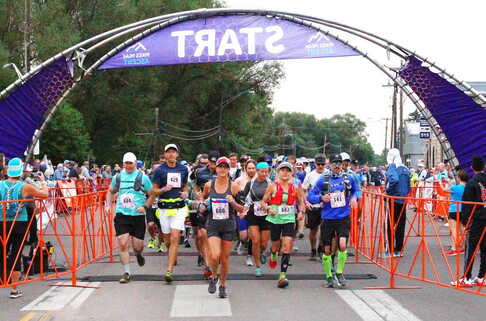Sean Rimmer, Physical Therapist & Running Coach at Run Potential Rehab & Performance in Colorado Springs, CO“Regain your confidence to run pain free & to your potential”  Photo Credit - Skip Williams Photo Credit - Skip Williams So you’ve signed up for the Pikes Peak Marathon or Ascent, now what? Well the simple answer would be to start some sort of training as Pikes Peak will demand a lot from you, both mentally and physically. Whether you’ve signed up for the Marathon or Ascent you will need to overcome a challenging course with an overall elevation gain of 7,815' (2,382m) from start to summit, an average grade of 11%, and high altitude conditions ranging from 6,300' (1,920m) at the start and 14,115' (4,302m) at the summit. If you’re only doing the Ascent, congratulations! You just need to overcome the grind up Barr trail from Manitou Springs to the summit. But, if you're one of the lucky ones who signed up for the Marathon, you will need to endure the descent from the summit back into Manitou Springs in one piece. In this 3-part training prep series, I will highlight early, mid-stage, and late-stage training for Pikes Peak Marathon and Ascent. Now, as a disclaimer, everyone’s background in training history is different and there are a multitude of other variables that can affect how and when you train. This training series will highlight training principles, not a specific training plan, that can be modified based on your baseline fitness, goals, health, and lifestyle.  Photo Credit - Peter Maksimow Photo Credit - Peter Maksimow Early Training: 5-Months until Race Day Early focus in your training should highlight building musculoskeletal strength, base aerobic endurance, and the least specific running based workouts of short duration at a high intensity. The ultimate goal of early training is to prepare your body for more training in the mid- and late-stages of Pikes Peak preparation. It’s important to have the opportunity to build on your training by avoiding “burnout” and remaining healthy (as this is never a guarantee), so you can progress your training over the next 5 months. You will need excitement to be present on the starting line if you want a chance to perform at your best on race day. In the early stages of training April-May, a recommended program could look like the following:
This is a safe and conservative place to start for the average recreational runner that will likely be accommodating to someone of working class with a family. At this stage of training, 3-5 hours of total training is likely adequate and sustainable for the average person. As I previously mentioned, your run training should be focused on building an aerobic base as well as shorter duration/higher intensity intervals (least specific to race day). Depending on where your fitness level is at, I recommend the following 3 types of runs per week:
The focus for the easy effort runs will be on low intensity activity to build your aerobic system which you will need to be efficient come race day. When you run, try to keep your heart rate (HR) at 75-80% of HR max. For example, if your HR max is 190 bpm, then you would likely keep your HR from 140-150 bpm during your run or brisk walk/run combo. However, because HR data can be skewed on wearable devices, I recommend using a conversational pace to gauge intensity where you can speak several sentences before requiring a breath. Keep your ego aside for this low intensity training, as you may need to walk intermittently during your runs if your perceived effort or HR gets too high, especially if you're on rolling or hilly terrain. This relatively lower intensity training will build the foundation to improve our body’s ability to utilize oxygen within our muscles and tissues while running, improve recovery between sessions, may reduce musculoskeletal tissue stress, and allow you to increase your training volume over time. These types of runs will help raise your floor or base fitness, but the running intervals will help raise your fitness ceiling. The interval run workouts are of short duration but rather intense. For the “on” portion of the intervals, you should be pushing yourself rather hard while focusing on speed and/or power output. If you are breathing hard where you can only get a few words out, you are doing this workout correctly. If you are using a HR to gauge intensity, this workout will often increase your HR to 95% of HR max if done correctly. I typically recommend these workouts on an uphill grade ranging 3-10% to reduce the risk of musculoskeletal injury while also increasing power output. Due to the intensity of interval runs, I recommend an equal “off”portion or recovery time to the run. That may mean a slow jog back down the hill or an easy walk to recover before the next “on” portion. Since PPM/A is rarely flat, beginning to implement uphill workouts as a training stimulus will be helpful as the training progresses. Strength or resistance training has been a controversial topic within the running community for some time now. But, there is value in not just building strength of your muscles, but to build capacity within your musculoskeletal tissues (ie. bones, tendons, ligaments, etc) through loaded movements. Strength or resistance training has also been shown in the literature to improve running economy; which describes how efficient we are as runners at utilizing the least amount of energy at a given pace. And lastly, as a physical therapist who works with runners, by improving our tissues capacity to handle heavy loads and variable speed of loading, our body often remains healthier as our training becomes more demanding. Early on in your PPM/A training, strength or resistance training 2x a week for 20-30 minute sessions should be all you need. I typically recommend strength or resistance training sessions to be on the same day (later in day) to a running interval workout or the following day. This allows for a potential reduction in soreness or fatigue on your running workout day. As your running volume progresses over the next few months, strength or resistance training will turn to more of a maintenance plan of 1-2x per week with less total reps and less eccentric loading to reduce soreness/fatigue. The two types of exercises I recommend to start training consist of the following:
Now, there are a multitude of resistance based exercises you could perform, but variations of these 3 exercises can get the job done for heavy and slow resistance movements:
These exercises hit all of the major muscle units while providing external load to further improve connective tissue capacity in your lower body. I typically recommend a warm up set for each for 10 reps, and 2-3 working sets. The first set at a moderate-heavy weight for 6-8 reps, and the final 2 sets at a heavy weight for 3-5 reps. The last 1-2 sets should be challenging, where you could often only get about 3 more reps. The plyometric exercises consist of body weight movements focused on the stretch-shortening cycle of your muscle-tendon units. These exercises are jumping or hopping based movements, focused on short ground contact time. Typically you only need a few sets of these exercises to get the job done, as you are already training plyometrics when you run. Here’s what I recommend:
For the double or single leg hops for power in place, I recommend 2 sets of 10-12 reps. The focus should be on relative stiffness in your hips, knees, and ankles to reduce ground contact time while producing power to increase your flight time. For the double or single leg reactive hops moving forward, you are basically doing the same thing but with some horizontal movement by hopping forward. I recommend 2 sets of 6-8 reps for the forward hops. This can be performed by taking a small hop forward, then taking your reactive and powerful hop forward from the initial hop. Then re-set for the next rep. I recommend training the plyometrics in the beginning of your strength session to be fresh prior to the heavy lifting, or you can train plyometrics on the same day as one of your easy runs. With any good training program, your training and fitness should progress over time. This guide provides a starting point with some practical tools that may work well if you are new to training. For the next 1-2 months, I recommend building your training off these initial guidelines by increasing the duration of any run, adding another run per week, or increasing the volume of intensity with a given running workout. I do not recommend altering volume, duration, or intensity together in any single week of training to reduce the risk of training error or injury. When it comes down to it, be smart, listen to your body, and enjoy the process of this training. Pikes Peak will be waiting for you come September. Stay tuned for Part 2 coming in June 2023. Comments are closed.
|
©
Pikes Peak Marathon






